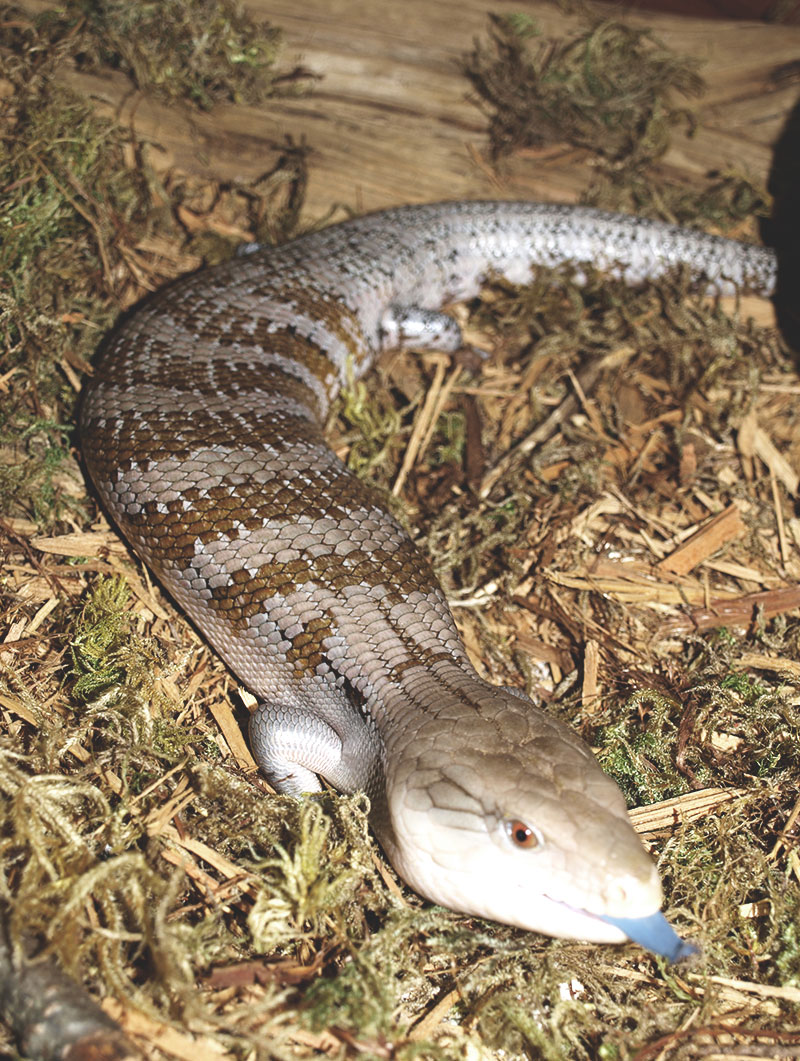Eastern Blue-tongued Skink
Tiliqua scincoides scincoides
Description:
The eastern blue-tongued skink is a lizard with a flat, broad body and short legs. Its overlapping scales are usually gray or brown in color, with a series of striped bands on the back and tail.
Size:
Eastern blue-tongued skinks measure an average of 17 inches (43.2 cm) long, with a maximum of 22 inches (55.9 cm). Their average weight is 10-18 ounces (283.5-510.3 g).
Adaptations:
- When it sees a predator, a blue-tongued skink can make itself appear more threatening by puffing up its body, sticking out its blue tongue, and hissing.
- Blue-tongued skinks have a powerful bite and will hang on for a long time without letting go.
- If a skink is grabbed from behind, it is able to drop its tail off. The moving tail distracts the predator while the skink gets away, and the skink can later regrow its tail.
- The flat bodies and shortened limbs of skinks make them well adapted for a life burrowing under the ground. Unlike most lizards, they do not walk on their feet. Instead, they slide on their bellies and use their feet to push themselves along. Their thick, muscular tails also help to propel their bodies through the soil.
- A skink’s ear openings are located near the back of its head to protect its ear membranes. Scales over the ear openings prevent dirt from entering.
Diet:
In the wild, blue-tongued skinks are omnivores that eat a variety of plants and animals including insects, snails, flowers, fruits, and berries. At Cosley Zoo, the skinks are fed fruits, vegetables, crickets, worms, and mice.
Reproduction:
Blue-tongued skinks breed in the spring. Gestation is 150 days. Females give birth to an average of 10 live young at a time, with a maximum clutch size of 25. There is no parental care, and the young skinks are on their own soon after birth. The young grow very quickly and can reach adult size in less than one year.
Shelter and space needs:
The eastern blue-tongued skink is native to the eastern coastal portion of Australia, and inhabits primarily woodlands and forests.
Life expectancy:
Eastern Blue-tongued Skinks can live up to 20 years.
Relationship with man:
Skinks make up an important part of the diet of many predators, such as raptors, snakes, and feral cats and dogs. They are also important predators of insects. Many people welcome skinks into their gardens to control populations of snails and insects.
Fun Facts:
- Blue-tongued skinks are ovoviviparous. This means that the young develop within eggs that hatch inside the mother’s body, so that they appear to be born alive.
- The eastern blue-tongued skink is the largest member of the skink family.
- The jaws of a blue-tongued skink are so strong that they can crush the shell of a snail!
- Although blue-tongued skinks are not native to Illinois, we do have three other species of skink (broad headed skink, ground skink, common five-lined skink) in this state. They all live in the southern part of the state and the largest is about 10 inches (25.4 cm) in length.






